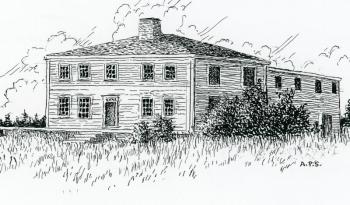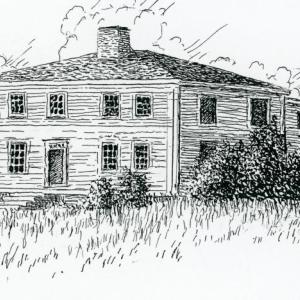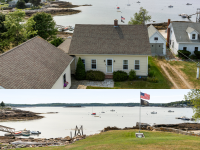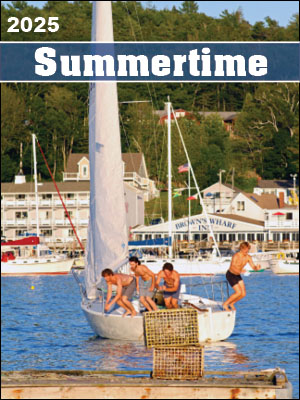Leach House: Its storied history recounted
From the Boothbay Region Historical Society’s files, here is another newspaper article (retyped) about the Leach House. We hope readers will get excited about visiting this historic landmark at the Society’s event scheduled for Saturday, Sept. 13.
Tickets for the event are $75 each with a limit of 75 guests. If you haven’t purchased your tickets yet, please do so online at www.boothbayhistorical.org or by sending a check to Boothbay Region Historical Society, P.O. Box 272, Boothbay Harbor, ME 04538, indicating “Leach Party” in the memo.
We would like to recognize our “Event In-Kind Sponsor” Mine Oyster, “Event Sponsor” First Federal Savings & Loan, “House Tour Sponsors” Knickerbocker Group and Colby & Gale, "Social In-Kind Sponsor" Brady's Restaurant, “Social Sponsor” Alan and Suzanne Cleveland, “Friends Sponsor” Hawke Motors, Inc. for your support of this event.
The Boothbay Register, Published in the Madeira of Maine in its Seventy-sixth year – No. 39 Boothbay Harbor, Maine. Sept. 26, 1952.
REGION’S OLDEST HOUSE HAS INTERESTING HISTORY
Great age, architectural beauty, and tales of violence and excitement combine to make the Sawyer’s Island summer home of Mr. and Mrs. Harold K. Merrow of Hyde Park, Mass., one of the most remarkable landmarks in the Boothbay Region.
Called by some “the oldest house now standing in Maine” – a title which historians have been unable to prove or disprove -- the Merrow house may be over 200 years old. The most conservative estimates indicate it is close to 192 years old.
Of course, not all of the present structure has reached this advanced age. The elements have taken their toll over the years, and various owners have done their share of adding, subtracting, and altering. Yet, in spite of this, and thanks to careful restoration on the part of the present owners, the house has kept much of its authenticity.
The house is a large, rectangular two-story building with a long ell and is painted a soft grey with green trim. The walls are of two-inch planks, set on end, something in the fashion of a stockade, probably as protection against the Indians. Clapboards have since been added. On the most sheltered wall of the house these clapboards are very old, though in good repair, and the butt ends are bevelled and over-lapped – a method of construction which is seldom seen today.
Served as an Inn
Prior to the American Revolution the house was used as an inn or tavern. Its size and the number of rooms would seem to bear this out, though the building was probably somewhat smaller in those early days.
It is like stepping into the eighteenth century to walk into the Merrow dining room today. This room was originally the kitchen, and the huge fireplace with its brick baking oven and the hand-hewn smoke blackened beams still stand. Many of the old side planks are left in the floor – some of them are from virgin timber, measure as much as two feet across.
Black iron pots and a kettle hang from the original fireplace crane, and Merrow family heirlooms such as a pine cradle, an ingenious iron toaster, a grandmother’s clock, and antique chests and chairs all look as if they were placed there when the house was first built.
There are fireplaces in the living room and in the master bedroom upstairs. The living room mantel piece is a collector’s item, and the old molding and woodwork is a delight to connoisseurs.
Tremendous granite blocks were used as the foundation of the house, blocks which must have needed strong men and, perhaps, even stronger oxen to move into place.
Known as Ship Island
The first record of the historic property to be found in the registry of deeds at Wiscasset is dated May 10, 1746. On this date Samuel Barter of Barter’s Island conveyed Ship Island (the early name for Sawyer’s Island) to Joseph Patten of Newbury, Mass. Patten also acquired Moorse’s Island (now known as Hodgdon’s Island) from Edward Moorse of Sheepscot by a deed dated Sept. 21, 1753. Nine years later on May 5, 1762, Patten sold Ship Island, Moorse’s Island and Indiantown Island with all buildings for the sum of 200 pounds to his daughter Alice.
The legality of Patten’s title is doubtful for some historians believe Samuel Barter had acquired nothing more than squatter’s rights to the property. Ship Island was included within limits of land granted by the king to the Kennebec Proprietors and was claimed by them.
No court battle ever developed. However, Joseph Patten, who was one of the first judges appointed when Lincoln County was formed in 1760, and his daughter Alice, disappeared without leaving a trace. There were other more deadly battles than those waged in courtrooms going on in the land. Whether the Pattens were killed by Indians or simply driven away to another part of the country, is not known.
In any case, by a deed dated March 31, 1762, the Kennebec Proprietors conveyed Ship Island to Silvester Gardiner. He in turn conveyed Ship Island and Indiantown Island to Israel David by a deed dated Nov. 23, 1762.
Date is Uncertain
Somewhere along the line the present building was constructed, but the date is obscure. According to some historians the house dates from 1750. Others believe the house was built by Joseph Patten shortly after he acquired a deed from Samuel Barter in 1746.
But it can also be argued that the present structure was not built until 1760. Patten may well have built a home on the island before the mid-point of the century. But the so-called Five Years War with the Indians from 1746 to 1749, and the French and Indian War from 1753 to the fall of Quebec in 1759 saw many a home burned to the ground in all parts of the state. Few, if any, in the Boothbay region escaped the Indians’ fire brands, and it would be remarkable if the Patten house escaped this fate. Of course, it is possible that it did.
In any case, there was a house on Ship Island when it was acquired by Israel David in 1762. This is substantiated by the fact that that gentleman held an Innholder’s License both for that year and in 1764 and ’65.
Israel Davis played an active role in the early history of the Region. He was the first moderator for the town of Boothbay and was one of the first members of First Church, Boothbay, which was dedicated on July 28, 1776. This church’s pastor was the famous John Murray. Mr. Davis became a visiting elder of First Church.
His career, however, also included the military and on Jan. 16, 1776, he was commissioned captain in Joseph Frye’s regiment. This regiment saw nine months’ service in the Boothbay and Sheepscot River area. Capt. Davis was then ordered to raise a second company for three years’ service in the regular army. Following orders, Capt. Davis marched his men to Cambridge, Mass., then to Saratoga, N.Y., where he was present for the surrender of Burgoyne. Later he and his troops joined General Washington’s army at Schuykill. During the latter part of the war, he served as sergeant of marines on a state vessel.
Since almost all travel was by water, Mr. Davis’ Inn on Ship Island was advantageously located for business purposes. Either business fell off, or other problems arose, for on March 22, 1764, Davis mortgaged Ship Island to Benjamin Sawyer for 120 pounds and five shillings.
Benjamin Sawyer, whose name stuck to the house for many years and because of whom Ship Island is now called Sawyer’s Island, apparently eventually took possession.
Attacked by British
While the house was advantageously located for use as an inn, it was uncomfortably prominent when another war came along. During the Revolution, Mr. Sawyer and his sons saw plenty of action in the neighborhood, and on one occasion came near to losing their home.
It must have been a dramatic moment when at daybreak one winter morning in 1781 a landing party put out from British brig which had anchored in Sheepscot Bay. The party headed straight for Deacon Sawyer’s house, and after robbing it of everything of value, set it on fire. When the raiders had departed, Sawyer and his family were lucky enough to extinguish the flames and save their home.
Some historians credit the British marauders with showing consideration for Deacon Sawyer’s daughter who was lying ill in bed at the time of the raid. Others, however, claim the invaders went so far as to steal the bed from under the unfortunate girl.
Benjamin Sawyer’s patriotism was unquestioned. Three of his sons were soldiers during the Revolution, while he himself built whale boats for the service. In 1775 he was on the Committee for Correspondence and in 1780 he served as selectman and town treasurer. During the war he lent the Massachusetts government a large sum of money, only to be repaid at a later date in depreciated currency.
Sawyer and his wife were still living on the island in 1790, for the Reverend John Gould has recorded in his diary he often went over to the island to see “Deacon Sawyer and enjoy a fish chowder on the rocks there.”
About 1809 Tyler Hodgdon moved to the island from Westport, purchasing the house from Benjamin Sawyer. The house later passed to Albion Hodgdon, Tyler’s son, and was owned by him and his heirs for many years.
When the Merrows purchased the property about 1917 it was owned Mrs. Etta Staples. The house was in bad shape then and in a few more years might have tumbled down completely.
Fortunately, however, the Merrows appreciated the beauty of old things, and today the house stands restored, an impressive and irreplaceable landmark, and a reminder of the Region’s history and tradition.


























